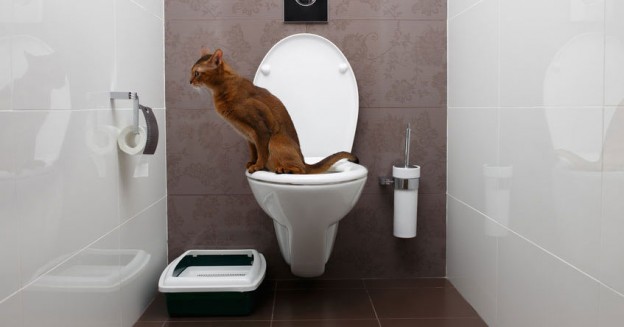Why Flushing Cat Poop Down Your Toilet Can Cause Problems - Recommendations for Proper Disposal
Why Flushing Cat Poop Down Your Toilet Can Cause Problems - Recommendations for Proper Disposal
Blog Article
We have come across this article on Don’t flush cat feces down the toilet down the page on the net and thought it made sense to write about it with you on this site.

Intro
As feline owners, it's necessary to be mindful of how we deal with our feline pals' waste. While it may appear hassle-free to purge feline poop down the bathroom, this practice can have harmful consequences for both the setting and human wellness.
Alternatives to Flushing
Luckily, there are much safer and much more accountable ways to deal with pet cat poop. Take into consideration the adhering to choices:
1. Scoop and Dispose in Trash
The most common technique of getting rid of cat poop is to scoop it right into an eco-friendly bag and throw it in the garbage. Make sure to use a specialized litter inside story and deal with the waste without delay.
2. Use Biodegradable Litter
Go with naturally degradable cat litter made from products such as corn or wheat. These clutters are environmentally friendly and can be securely dealt with in the garbage.
3. Bury in the Yard
If you have a backyard, take into consideration hiding feline waste in an assigned location away from vegetable yards and water sources. Make sure to dig deep adequate to prevent contamination of groundwater.
4. Mount a Pet Waste Disposal System
Invest in an animal waste disposal system especially made for cat waste. These systems utilize enzymes to break down the waste, reducing odor and environmental effect.
Health and wellness Risks
In addition to ecological issues, flushing feline waste can likewise position health dangers to people. Cat feces might include Toxoplasma gondii, a parasite that can cause toxoplasmosis-- a potentially extreme health problem, especially for pregnant females and individuals with weakened body immune systems.
Ecological Impact
Flushing feline poop presents harmful microorganisms and parasites right into the supply of water, posturing a significant threat to aquatic communities. These pollutants can negatively impact marine life and compromise water quality.
Conclusion
Responsible pet ownership expands past giving food and sanctuary-- it additionally entails correct waste monitoring. By avoiding purging feline poop down the bathroom and choosing alternate disposal techniques, we can lessen our environmental footprint and protect human health.
Why Can’t I Flush Cat Poop?
It Spreads a Parasite
Cats are frequently infected with a parasite called toxoplasma gondii. The parasite causes an infection called toxoplasmosis. It is usually harmless to cats. The parasite only uses cat poop as a host for its eggs. Otherwise, the cat’s immune system usually keeps the infection at low enough levels to maintain its own health. But it does not stop the develop of eggs. These eggs are tiny and surprisingly tough. They may survive for a year before they begin to grow. But that’s the problem.
Our wastewater system is not designed to deal with toxoplasmosis eggs. Instead, most eggs will flush from your toilet into sewers and wastewater management plants. After the sewage is treated for many other harmful things in it, it is typically released into local rivers, lakes, or oceans. Here, the toxoplasmosis eggs can find new hosts, including starfish, crabs, otters, and many other wildlife. For many, this is a significant risk to their health. Toxoplasmosis can also end up infecting water sources that are important for agriculture, which means our deer, pigs, and sheep can get infected too.
Is There Risk to Humans?
There can be a risk to human life from flushing cat poop down the toilet. If you do so, the parasites from your cat’s poop can end up in shellfish, game animals, or livestock. If this meat is then served raw or undercooked, the people who eat it can get sick.
In fact, according to the CDC, 40 million people in the United States are infected with toxoplasma gondii. They get it from exposure to infected seafood, or from some kind of cat poop contamination, like drinking from a stream that is contaminated or touching anything that has come into contact with cat poop. That includes just cleaning a cat litter box.
Most people who get infected with these parasites will not develop any symptoms. However, for pregnant women or for those with compromised immune systems, the parasite can cause severe health problems.
How to Handle Cat Poop
The best way to handle cat poop is actually to clean the box more often. The eggs that the parasite sheds will not become active until one to five days after the cat poops. That means that if you clean daily, you’re much less likely to come into direct contact with infectious eggs.
That said, always dispose of cat poop in the garbage and not down the toilet. Wash your hands before and after you clean the litter box, and bring the bag of poop right outside to your garbage bins.
https://trenchlesssolutionsusa.com/why-cant-i-flush-cat-poop/

I am just very intrigued by Don’t flush cat feces down the toilet and I'm hoping you enjoyed our piece. Sharing is caring. You won't know, you could be doing someone a favor. I am grateful for your time. Don't hesitate to stop by our website back soon.
Click Here Report this page